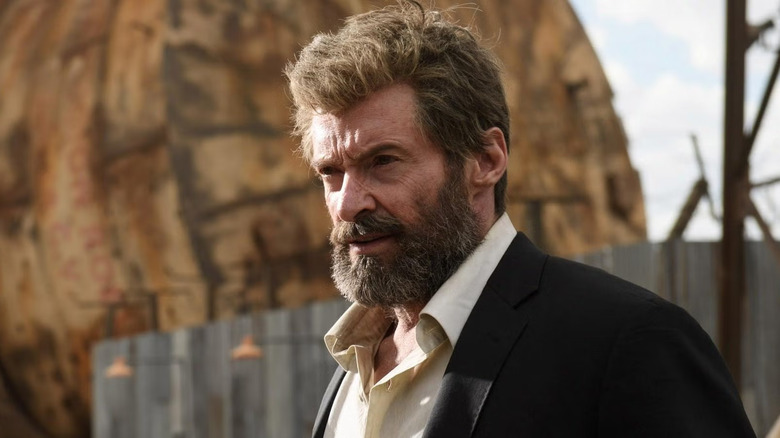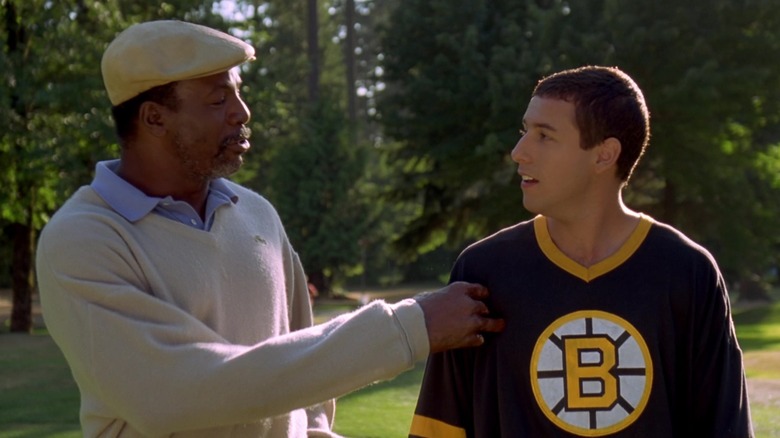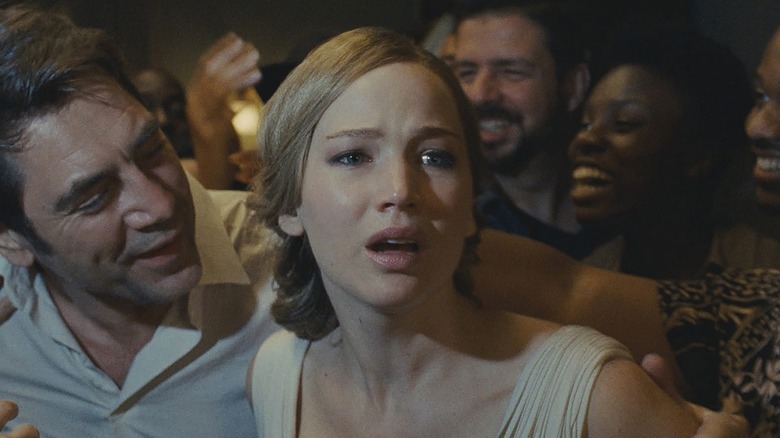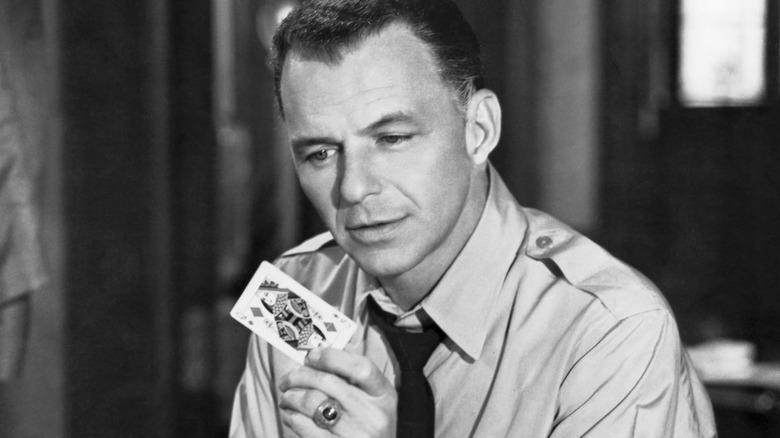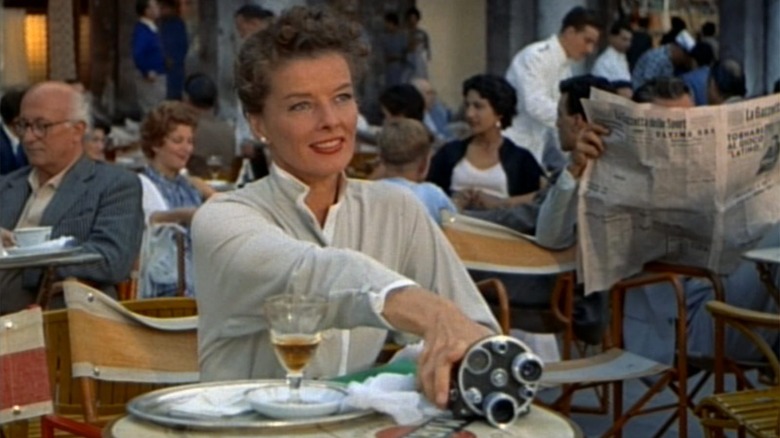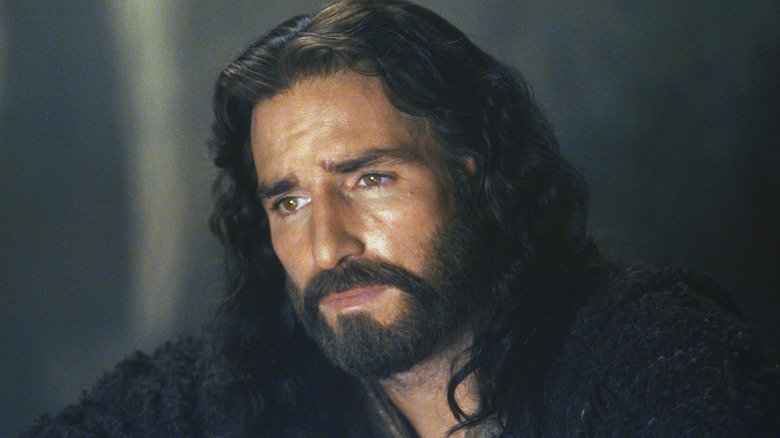Actors Who Damaged Their Bodies Forever For A Movie Role
We may receive a commission on purchases made from links.
The film industry has a long history of on-set accidents and injuries. They are often a result of many different factors: human error, unsafe working conditions, and directors who insist on doing anything necessary to make the film look "real," among other things. Of course, over the years, stricter measures have been taken to keep cast and crew safe on set, but we'll still see the occasional incident make headlines, leading us to wonder what could have been done to avoid it.
In most cases, these injuries are treatable, even if production is delayed to account for rest and relaxation. However, sometimes, the injuries are not curable; they can even leave lasting damage to an actor's body that affects the rest of their lives and careers. From permanently dislocated body parts to severe allergic reactions, anything can leave a mark under the right (or wrong) circumstances. Here are 13 of some of the most shocking yet fascinating examples.
Carl Weathers (Happy Gilmore)
Amidst a career of memorable performances, Derick "Chubbs" Peterson from "Happy Gilmore" is far from Carl Weathers' most recognizable role to the average cinephile. However, for Weathers, he will always remember "Happy Gilmore" due to an injury he sustained on set. His time on screen as Happy's newfound golf coach and mentor is short, yet the pain he experienced shooting the film would last for years after the film's 1996 release.
The injury came from a blind pratfall that comes toward the film's third act. After Happy gifts him the head of the alligator who bit off his hand, Chubbs falls to his death out a window. "There [were] stunt bags [that were] two feet tall," Weathers explained to GQ, "but the bag wasn't pushed all the way against the wall, so when I went out backwards instead of hitting something flat, my body kind of got trapped, my head on the bags, and my tailbone at the wall, and so it just would crunch on the spine."
It wasn't until years after the incident that Weathers found out he fractured two spinal vertebrae and developed bone spurs. "[My spine] did a kind of self-fuse in a really bad place. There were three or four years there where I was just in excruciating pain." By the time he got to a surgeon, he was told they would only make it worse. However, thankfully, Weathers' pain faded away in the years that followed and allowed him to continue his career before his passing in February 2024.
Jennifer Lawrence (mother!)
To call "mother!" an intense movie would be putting it gently, but nobody had it worse than star Jennifer Lawrence. The Oscar-winning actress plunged into the depths of emotional devastation for Darren Aronofsky's environmentalist allegory, which retells both the Old and New Testaments from Mother Earth's perspective. This includes the nativity and Jesus Christ's crucifixion, which takes the form of a young mother's newborn baby being brutally killed, mangled, and eaten by a group of cultists.
Lawrence's character proceeds to have an emotional breakdown, but the actress was hyperventilating so hard shooting the sequence that she tore her diaphragm and dislocated a rib. She attributes the incident to her commitment to the role, noting in an interview with Deadline that this role was the first time she fully immersed herself in a performance to the point where she struggled to turn it off between takes. In her recent appearance on "Hot Ones," Lawrence confirmed that the rib "still clicks to this day."
Beyond that, the injury has not proven to be fatal to either J-Law's life or career. The actress has continued to appear in a wide variety of films, including the comedy "No Hard Feelings." However, when Entertainment Weekly asked if she would ever do a movie like "mother!" again, she quickly said no, believing she "wouldn't be able to do it again." Based on her injury, it's not hard to see why.
Hugh Jackman (The X-Men franchise)
Anyone who has seen Hugh Jackman in the ADR booth knows the beloved song-and-dance man knows how to go hard. His indelible legacy as Wolverine in the "X-Men" franchise came partially from his animalistic physicality, which was increasingly heightened with each successive installment. In combination with his grizzly vocal tone, Jackman's level of exertion brought out more than a few grunts and growls. However, it appears that the years have taken their toll on Jackman's actual voice.
In an interview with audio program Front Row, Jackman admitted he has done "damage to [his] voice" playing Wolverine. He specified his falsetto is "not as strong as it used to be," which directly ties into his work as a musical theater performer. The falsetto is the highest portion of a singer's vocal range; over-exerting one's vocal cords can make it tougher to achieve falsetto singing. Despite Jackman's attempts to take care of his voice, Logan proves to be too intense a character to play it safe.
Thankfully, this damage hasn't kept Jackman off the stage. Earlier this year, he concluded a hugely successful Broadway turn as Professor Harold Hill in "The Music Man," though Jackman has not spoken about any future Broadway plans. In addition, Jackman will return to the role of Wolverine for "Deadpool 3," which promises to be another rip-roaring (literally) adventure, reportedly through the multiverse. Let's hope he packed some lozenges for this go-around.
John Hawkes (The Sessions)
Most of the time, life-changing injuries occur in films that are high-stakes. However, sometimes, damage can be done in even the quietest performances. Case in point: John Hawkes' beautiful turn in the immensely popular sexy dramedy "The Sessions." Hawkes plays Mark O'Brien, a poet who is paralyzed from the neck down due to complications from polio. In an effort to lose his virginity before he dies, he hires an intimacy surrogate (Helen Hunt, who went on to be nominated for an Oscar), and sparks fly.
Due to his illness, O'Brien was always in a laid-down position, and his spine was severely curved. In his words, Hawkes sought to "honor [that]" in his portrayal; he worked with the film's props department to create a soccer ball-sized piece of foam that would go underneath the left side of his back while filming, recreating O'Brien's spinal curve. In an interview with Vulture, Hawkes jokingly called this prosthetic "the torture ball," though that name does allude to how much pain the actor experienced while filming.
In that same interview, Hawkes revealed that he retains back problems from shooting the film, despite doing yoga between takes. According to his chiropractor, due to the spinal imbalance caused by the foam, one side of his spine "doesn't have enough movement" as the other. The actor admitted he would likely "carry some of that [pain] the rest of [his] life" but recognized it would only be a fraction of the real pain O'Brien endured throughout his life.
Russell Crowe (Gladiator, Cinderella Man, Robin Hood)
In the pantheon of permanent on-set injuries (is it bad that there is one?), most actors have one, maybe two, to their name. Somehow, Russell Crowe has countless, all spanning different roles he has taken throughout his career. It's no surprise that none of these injuries have significantly affected Crowe or his ability to continue acting. But the extensive rap sheet is still shocking, especially considering how persistently exacerbated they have been over the years.
Crowe broke down all his long-term injuries in an interview with Vulture, including multiple shoulder surgeries, grade-four tears in his Achilles tendons, and a complete lack of cartilage in his toes. The reasons for his injuries are mostly due to the intensity of his roles. "Mystery, Alaska" had Crowe in ice skates for 12- to 14-hour days, "Cinderella Man" saw Crowe train to become a genuine heavyweight boxer, and "Robin Hood" featured extensive stunt work. He was even injured during pre-production for a film he never ended up doing.
Many of Crowe's injuries stem from arguably his most well-known role: Maximus in Ridley Scott's "Gladiator." In his episode of "Inside The Actors Studio," Crowe discusses the many brunts he took on the set: skin discoloration, blown-out knees, scars, back problems, a dislocated rib, and the aforementioned Achilles tendon tears, amongst other things. Later in that same interview, Crowe explains that he "physically commit[s]" to doing his own stunts so that, simply put, "the director can get the shot."
Charlize Theron (Atomic Blonde)
Charlize Theron has had a long history of on-set injuries. She sustained a shoulder injury filming "The Old Guard," tore a stomach muscle for "Snow White and The Huntsman," and was almost paralyzed after a neck injury all the way back in 2006 shooting "Æon Flux." However, her least significant injury was the one that left the most permanent damage. While working on "Atomic Blonde," her most stunt-intensive film thanks to the radical mind of acclaimed action director David Leitch, Theron clenched her teeth so hard during training that she cracked two of them.
In an interview with Variety, the actress explained that she was forced to undergo surgery before the film began shooting. "Having to cut one of the teeth out and root canals, it was tough ... I had the removal and I had to put a donor bone in there to heal until I came back, and then I had another surgery to put a metal screw in there."
Theron is likely referring to the process of dental bone grafting, in which new bone material (potentially donated) is added into your gums to help maintain jaw shape and condition. After this has healed, a dental implant and crown is added on top. It can be an extensive and long-term process, and at the Q&A following the film's SXSW premiere in March 2017, almost two years after training began, she was still enduring it. Thankfully, even with tooth replacements, Theron's smile is still a winning one.
Linda Blair and Ellen Burstyn (The Exorcist)
The violence in horror films often makes them prone to on-set difficulties and potential accidents. William Friedkin's thrilling classic, "The Exorcist," had so many production problems that it spawned its own supposed curse. Many injuries occurred on set, including two life-changing fractures for the film's two leading ladies: Linda Blair (the possessed child Regan) and Ellen Burstyn (Regan's disturbed mother, Chris).
Blair, who was 12 years old at the time of filming, was encouraged to do the majority of her own stunts. One of these involved being strapped to her bed with a harness. The harness was not well-fastened, causing it to repeatedly hit Blair's spine. Due to further technical failure, her back was fractured during the film's climactic levitation scene, the take of which is featured in the final film. This, in combination with a car accident later in life, led to her developing scoliosis.
Meanwhile, Burstyn fractured her tailbone in a separate incident, which she describes in the film's 1988 making-of documentary, "The Fear of God." During the scene when Regan slaps Chris, Friedkin had Burstyn pulled down to the floor with a wire. After the first take, Burstyn told Friedkin that the pull was too harsh. She requested less force, a request Friedkin ultimately ignored. The wire was pulled even harder, and Burstyn was sent to the hospital. That take was also used in the final film, agonizing scream and all. She was on crutches for two weeks but sustained long-term injuries to this day.
Buster Keaton (Sherlock Jr.)
It's easy to have a good laugh while watching a Buster Keaton gag, but you likely wouldn't be laughing if you knew how much it hurt. Or, maybe you'd laugh more? Either way, this king of silent cinema took quite a beating. Keaton famously did all his own stunts, injuring himself on every feature film he ever produced. He subsequently grew an immense tolerance for physical pain, so much so that his most serious injury took him 11 years to discover.
In Marion Meade's biography, "Buster Keaton: Cut to the Chase," she explains the stunt that did him in, as featured in "Sherlock Jr." While escaping from a moving train, Keaton grabbed onto the spout of a water tank, which gently lowered him to the ground. Keaton did not expect water to begin gushing out of the spout with great force. It was so powerful that his grip loosened. He fell backward, his neck landing directly along the railroad track. He immediately blacked out and, in a rare move, called off filming for the rest of the day. However, Keaton resumed production the following morning.
"Sherlock Jr." would be released in 1924, but it wasn't until a doctor's appointment in 1935 that an X-ray revealed that Keaton had a fracture in his neck, which he was never aware of. He could only attribute it to his fall onto the railway. Despite this, Keaton never stopped working — though he did sign up for life insurance — but it is unclear if his neck ever healed.
John Wayne (Reap The Wild Wind)
Western fans will forever have an icon in John Wayne, however his career also features a scattering of non-gunslinger naval dramas. One of these films was "Reap The Wild Wind," a romantic epic directed by Cecil B. DeMille, in which Wayne played a shipwrecked captain caught in a high-stakes love triangle along the Florida Keys. Though the film is relatively obscure to mainstream movie fans, its production left Wayne with a long-term injury.
The climax of "Reap The Wild Wind" sees the film's two leading men exploring an underwater shipwreck, which resulted in John Wayne being pit against a giant squid in a shining example groundbreaking practical effects for the time. According to biographer Ronald L. Davis' book "Duke: The Life and Image of John Wayne," the diving sequence was filmed using a water tank that was the size of a football field. Wayne and co-star Ray Milland spent ten days in bulky diving suits and were, at times, up to 20 feet underwater.
Wayne spent so much time submerged in the tank that he developed a chronic inner-ear condition; though specific details have long been unconfirmed, it is possible the injury was a barotrauma caused by being unable to equalize ear organs to deep water pressure. This injury, along with long-held back pain from a reputation for doing his own stunts, led to Wayne being denied from serving in World War II. This would plague Wayne's conscience for the rest of his life, however, it also contributed to his iconic persona as the no-nonsense American hero that drove decades of cinema.
Jackie Chan (Armour of God)
For actors who do their own stunts, look no further than martial arts icon Jackie Chan. The man has been injured countless times in countless ways throughout his decades-spanning career: broken noses, teeth knocked out, fractured bones, you name it. In his autobiography, "I Am Jackie Chan: My Life in Action," he devotes an entire chapter to detailing all of these injuries (by body part) and specifically recounts his worst on the set of the Hong Kong action-comedy "Armour of God."
In the film, Chan plays an Indiana Jones-adjacent adventurer who does several high-flying stunts, one involving jumping from a castle wall onto a nearby tree branch. According to Chan, it wasn't supposed to be anything special and even went smoothly on the first try. However, Chan was unsatisfied with the take and requested to do another. This time around, the branch broke, and Chan fell headfirst to the rocky ground below. His head hit a rock, sending a fractured piece of his skull straight into his brain, which caused internal bleeding.
Chan required emergency 8-hour brain surgery, which was successful. However, it required a plastic plate to be inserted into his brain to plug up the hole, which remains to this day. The actor was also left hard of hearing in one ear, another permanent side effect. Footage of the accident appears at the end of "Armour of God," and Chan recalls the stunt as the closest he's ever come to death.
Sean Bean (Patriot Games)
One does not simply injure Sean Bean... unless you're Harrison Ford. The two revered actors starred opposite each other in "Patriot Games," one of the many action thrillers featuring Tom Clancy's character Jack Ryan. Bean portrayed the film's villain, terrorist Sean Miller, who swears to avenge his brother's murder at the hands of Ryan, portrayed by Ford. While Ford was a household names, thanks to "Star Wars" and "Indiana Jones," Bean had yet to be properly introduced to American film audiences, making this his breakout Hollywood role.
Sadly, his welcome was less than warm. While reshooting the film's climactic fight scene atop a flaming speedboat, LA Times reported that Ford swung a boat hook at Bean and slashed his face underneath his eyebrow — audiences can actually see Bean bleeding in the final film. The British actor had to go to the hospital and receive eight stitches afterwards (via MyLondon), however a permanent scar still remains. That said, Bean is far from resentful over the injury. "It's a good one," he told Spectrum News 13. "It's in the right place. Kind of a designer scar."
This unfortunate incident would pave the way for Bean's career. Directly following "Patriot Games," Bean portrayed soldier Richard Sharpe in the British television series "Sharpe." Bean took on the role last-minute, which led to the show's makeup artists accentuating his scar and the writers adding it into his backstory. This would be the first in a series of rugged but honorable roles, including Boromir in "Lord of the Rings" and Ned Stark in "Game of Thrones."
Buddy Ebsen (The Wizard of Oz)
"The Wizard of Oz" is one in a long list of classic movies that were not made under the safest conditions. Many are already aware of the physical and emotional abuse Judy Garland experienced on set and a pyrotechnic accident that left Margaret Hamilton and her stunt double with third-degree burns. However, Buddy Ebsen was left with the most permanent damage — and he didn't even end up in the film.
We all know Jack Haley as the Tin Man, but Ebsen was originally set to play the character. He had even recorded all the songs and underwent extensive makeup tests, the latter of which was his undoing. According to Ebsen's autobiography, "The Other Side of Oz," the crew had settled on white clown face paint coated with dust made of pure aluminum. After all, he was a Tin Man. Throughout the shoot, Ebsen would occasionally sweat off the dust, so it was constantly reapplied. According to him, "It was impossible not to breathe the stuff."
Ebsen began to have difficulty breathing on set and, one night after shooting, woke up completely unable to. He was sent to the hospital, where they discovered that his lungs had been fully coated in aluminum dust, causing a toxic reaction. Ebsen recovered eight weeks later; during that time, he was replaced by Haley. Though Ebsen went on to have a successful career, he said the incident left him with "a tendency toward bronchitis" and a need for air filtration systems in his home.
Frank Sinatra (The Manchurian Candidate)
Many people forget that Frank Sinatra, on top of being one of the most successful recording artists of all time, was also an accomplished, committed actor. The man won an Oscar, but he also almost lost a finger. Ol' Blue Eyes was injured while filming John Frankenheimer's "The Manchurian Candidate," an adaptation of Richard Condon's 1959 novel. Sinatra plays Ben Marco, a captain who returns from the Korean War to discover Communist soldiers brainwashed him and his platoon.
When Marco suddenly encounters a Korean agent, played by Henry Silva, the two engage in a messy karate match, destroying a fellow soldier's apartment. For one stunt, a mistake in the fight choreography led to Sinatra chopping into a real coffee table — not a breakaway prop, as is standard for fight scenes. He struck it so hard that he broke off a piece of the table and fractured his right pinky finger. Despite the take being a mistake, it appears in the final film.
According to Nancy Sinatra's book about her father, Ol' Blue Eyes continued shooting the scene despite the injury and never sought proper medical attention; in a special 26th-anniversary interview, Sinatra shows off his finger, which appears to have limited movement. Though Sinatra remained successful, the injury caused him discomfort for the rest of his life and, funnily enough, cost him his shot at playing "Dirty Harry." Sinatra was initially attached to the project, according to "Gods Like Us: On Movie Stardom and Modern Fame," but couldn't hold the character's signature pistol. He dropped out, though they managed to find a solid replacement.
Brendan Fraser (The Mummy franchise, et. al)
Across the 2000s, Brendan Fraser was an action star. His slew of commercial successes, most notably the now-beloved "Mummy" franchise, turned him into a household name and a bonafide hunk. However, it wouldn't be until 10 years after his final "Mummy" film that Fraser would reveal the intense physical damage his body endured as a result of his blockbuster stunt work.
In a revealing interview with GQ in 2018, Fraser spoke about the seven years spent attending hospitals to treat his numerous injuries. "I needed a laminectomy," he explained, which is a procedure that removes lamina vertebrae to ease pressure on the spine. "The lumbar didn't take, so they had to do it again a year later." He also had compressed spinal pads bolted together, but this was all just for his back. His partial knee replacement and vocal cord surgery proves his entire body was put through the ringer. Fraser said, "By the time I did the third Mummy' picture ... I was building an exoskeleton for myself daily."
These injuries, along with his allegations against former Hollywood Foreign Press Association President Phillip Berk, kept Fraser out of the spotlight for many years. However, with his Oscar-winning performance in Darren Aranofsky's "The Whale," Fraser has seen a resurgence in popularity. That said, Fraser won't be doing any more stunt work anytime soon. "I'm older now; I don't look the way I did in those days, and I don't necessarily want to," Fraser told The Daily Telegraph. "I've made peace with who I am now."
Jackson Rock Pinckney (Cyborg)
You probably don't know the name Jackson "Rock" Pinckney (pictured leftmost above), nor may you know the 1989 film "Cyborg." The amateur bodybuilder and short-lived stuntman appeared briefly opposite legendary martial artist Jean-Claude Van Damme, who starred in the film following his breakout success with "Bloodsport." Unfortunately, Pinckney's on-screen potential was cut short following an on-set injury from Van Damme that left Pinckney without vision in his left eye. The two would eventually go to trial over the incident in a heavily publicized blight on Van Damme's career.
During rehearsal, Pinckney and Van Damme had practiced a fight scene that involved the latter striking the former against the chest with a prop knife. Van Damme had initially tucked the knife along his forearm for safety. However, when cameras were rolling, Van Damme instead held the knife "like a hammer" (via Black Belt Magazine) and accidentally struck Pinckney in the left eye. Van Damme claimed that Pinckney had moved too far forward from an on-set mark, causing him to misjudge the attack distance. The argument against Van Damme was his well-known desire for "realistic" fight scenes, which lessened the margin of safety.
Pinckney sued Van Damme for $800,000, along with punitive damages. Though the jury decided that Van Damme was guilty of "willful and wanton negligence," they struck down the punitive damages and only charged him $487,000 (via Associated Press). Still, Pinckney won the trial and was able to support himself and his family following discharge from the United States Army due to his injury.
Burt Reynolds (City Heat)
Burt Reynolds' string of commercial flops in the '80s left his stardom in the dust faster than any of his memorable car chases. However, it wasn't merely the quality of the work that proved to be fatal. One on-set accident while filming 1984's "City Heat" set Reynolds' career back further than any other project. The crime comedy paired him with fellow icon Clint Eastwood as former partners, now frenemies, who begrudgingly reunite to take down a group of mobsters. "The first night of shooting was magical," Reynolds recounts in his memoir, "But Enough About Me," however things took a turn when they began shooting a fight scene. "I was supposed to get hit in the head with a breakaway chair, but the guy grabbed a metal chair by mistake and caught me flush in the jaw."
Reynolds was diagnosed with temporomandibular disorder, or TMD, which occurs when the joint connecting your jaw to your skill is dislodged. It causes both immense jaw pain as well as crippling sensitivities to light and sound, both of which debilitated Reynolds to the point that he wouldn't work for two years. The actor sought medical attention for years to no avail, at one point sawing all of his bottom teeth off in an attempt to cure his condition (spoiler alert: it didn't work). Eventually, he found a dentist who was able to realign both his jaw and every individual tooth in his mouth. As he wrote in the book, "Very slowly, I began to get better."
Katharine Hepburn (Summertime)
Hollywood's favorite leading lady was and arguably still is Katharine Hepburn. She was known for her brazen confidence and independence, yet could still melt your heart with one solemn look. Toward the end of her career, that look would always feature watery eyes, but Hepburn's crying was not always intentional. Part of it was due to a rare, incurable form of conjunctivitis she contracted after performing a stunt on the set of her 1955 film "Summertime," as detailed in Anne Edwards' biography, "A Remarkable Woman."
David Lean's romantic dramedy saw Hepburn as a middle-aged spinster vacationing in Venice, Italy. In one scene, Hepburn was to accidentally fall into a canal, but the actress — still dealing with a case of dysentery — was hesitant to do the stunt herself, even more so upon seeing the extremely dirty water of the Venice canals. Lean attempted to douse the water with disinfectant to quell Hepburn's worries, but the chemicals' density caused the water to strangely bubble, making Hepburn even more skeptical.
After bringing in some wind machines (as well as covering Hepburn in Vaseline), Lean convinced Hepburn to do the fall. She wound up doing four takes before Lean got the shot, however, one of her eyes began to bother her that night. That became conjunctivitis (an infection of the eye's lining), which plagued her for the rest of her career. Thankfully, she wound up using it to her advantage; her performance in "Summertime" garnered her an Oscar nomination.
Taylor Hickson (Ghostland)
Folks in America may know actress Taylor Hickson from her leading role as queer witch Raelle in Freeform's "Motherland: Fort Salem." Some may even recognize her as Meghan Orlovsky, a young teenager Wade Wilson assists toward the beginning of "Deadpool," pre-red spandex. However, one of her juiciest roles came from a Canadian-French co-production, "Ghostland" (also known as "Incident in a Ghostland"); Hickson plays the younger version of Vera, one of two daughters who reunite at their mother's old home, only for past traumas to rear their ugly head.
Sadly, this role came with a tragic on-set accident that led to a lawsuit (via Deadline). The suit alleged that Hickson, while shooting a scene involving a glass door, was asked to pound hard on the glass in order to sell the emotion of the scene. When asked if it was safe to do so, director Pascal Laugier and his producers told her yes. However, the glass door inevitably shattered; Hickson fell through the door and into the shards, cutting the left side of her face and requiring 70 stitches.
The lawsuit led to the film's production company, aptly titled Incident Productions, being fined $40,000, specifically for failing to uphold the Workplace Safety and Health Act. After enduring laser and silicone treatments, Hickson was left with permanent facial scarring from the accident, which can still be seen across the actor's chin and left cheek to this day.
Jim Caviezel (The Passion of the Christ)
Jesus Christ may have died for our sins, but was he ever struck by lightning? To play the religious figure in Mel Gibson's box office hit "The Passion of the Christ," Jim Caviezel endured his own suffering, including a dislocated shoulder from carrying the iconic cross, cuts from the chains he was shackled to, and yes, the actor was even struck by lightning, which led to an open-heart surgery (via Fox News).
The list goes on and on, but the most permanent mark was left during a scene in which Jesus is whipped in front of a crowd as punishment. "There was a board on my back, about a half-inch thick, so the Roman soldiers wouldn't hit my back," Caviezel explained to Newsweek promoting the film's release. "But one of the soldiers missed, hit me flush on the back and ripped the skin right off ... It's so painful that it shocks your system."
The actor recalled getting visibly angry with the actor who hit him, but that wasn't enough to save him from being accidentally whipped again. The hit caused Caviezel to quickly walk off-set and fall to the ground, his diaphragm frozen from shock. Though Caviezel recovered, a 14-inch gash was left on his back that remains to this day as a visible scar. This shocking blow would not make the final cut, though some of Caviezel's actual blood can be seen in other scenes.
